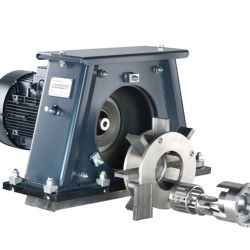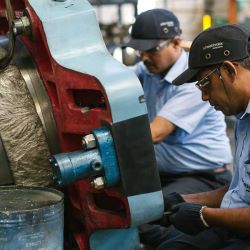Digital integration and real-time data collection in shot blast machines offer companies the ability to closely monitor operations, promptly identify anomalies, receive alerts for potential issues, and intervene proactively. This approach significantly reduces the risk of minor operational hiccups escalating into major problems, ultimately enhancing operation efficiency, and minimizing downtime. (see customer example below). Most importantly, you build a history of data on your own process to analyze and learn from. This additional know-how can be built into dashboards and alerts, to ensure fewer and less experienced operators can monitor the process and look after the machine. The results? A more stable process, higher quality output, and more efficient resource and energy use.
A Fast Start to Digitally Assisted Blasting
A network gateway is all it usually takes to digitally-enable even older shot-blast machines. These edge devices collect data from PLCs, sensors and other sources and send them to a central platform.
We use the Monitizer® NoriGate solution to digitally enable Wheelabrator equipment. This solution can also be installed on many types of equipment from almost any vendor.
Available in real time for monitoring, the data can also be stored in an existing Industry 4.0 system or a cloud application. Through it, data can be accessed, viewed, and analyzed on easily configurable dashboards or using pre-set tools. If data is being collected across an entire process, shot-blast data not only helps improve blast operations but can generate insights into how other parts of the process can be improved too. For example, data on reasons for machine idling can point to issues with production flow, while feedback from the abrasive recycling system could indicate a problem during shake-out on a molding line.
Cut Blasting Costs
Using digital integration to reduce blasting costs delivers the biggest gains early on and rapidly covers the cost of the initial digital installation. A set of ready-made, proven digital tools is available to tackle the top three shot-blast cost drivers: energy use, abrasive consumption, and maintenance. To give an example of the potential payback, a digital tool that reduces idle time by one hour per day could save over $10,000 annually in energy cost alone (on a machine with eight 50HP blast wheels, running in three-shift operation, 240 days a year).
But the benefits extend well beyond those three metrics. Optimizing abrasive consumption can shorten cycle times, save energy, and reduce wear, while cutting energy use (through the clever management and minimization of idle time) and minimizing maintenance can free up capacity and maximize productivity.
Beginning in this simple way helps operators, production managers and engineers learn more about their process and how to extract knowledge from the data – expertise they can apply and extend in future.
Case Study – Reducing Waste with Digital Monitoring
At one premium tool manufacturer who piloted our solution early on, forged parts were blast-cleaned and then coated, so blasting had a major influence on product quality. The business had reduced rework rates substantially using conventional techniques but realized that it needed data-driven insight to identify further improvements.
For the pilot project, it digitized a Wheelabrator Tumblast machine to make real-time process data available. With its process now dashboards were created to generate and track relevant metrics and KPIs.
One of the most important goals was to constantly optimize the abrasive mix which would have a major influence on blast quality, intensity, and stability.
Digital data revealed regular unexplained spikes in abrasive consumption which turned out to be the rotary screen clogging due to insufficient cleaning – a simple maintenance error. Clogged screens meant the abrasive overflowed, straight into the waste. Discovering and correcting this error significantly improved process stability, cut abrasive consumption and reduced the rework rate.
With real-time digital monitoring, a traffic light system alerts operators and managers if target values are exceeded. The company can now better control and stabilize its blast process – and so improve quality.
The project lead at the customer said: “The operating mix has been easy to neglect because you have to go up the ladder on the machine and look inside to check the screens. When something goes wrong, you often only see it at the end; and that means rework. With one glance at the dashboard, we can see when maintenance is needed and can intervene before the blast process runs off course. We are finally driving with a clear view of the road ahead.”
Artificial Intelligence for Better Blast Machine Maintenance
The digital tools described above are effective, but only a starting point. Their delivery platform is capable of running even more advanced digital technologies such as artificial intelligence (AI).
These tools can cut shot-blast maintenance (through AI-driven early warning systems, for example) and cost. They could even eliminate unscheduled downtime entirely, making better use of scarce maintenance personnel. For maintenance-intensive equipment like shot-blast machines, this could be a game changer.
Another development currently underway employs digital image analysis to monitor abrasive condition in real time. The idea: automatically recognize sub-standard abrasive particles to keep the operating mix at the precise optimum. This opens the door to completely automatic, digital process control.
Advanced process control tools for high-spec blast processes have enormous potential, with almost no limit to the number and type of data feed they can process. From built-in AI capabilities to automatic corrective measures that kick in when set values are exceeded – we are not that far away from a self-correcting blast process.
Transform Blast Performance
Current digital applications monitor process parameters and tackle the main shot-blast cost drivers, but there is immense additional potential for improved process control and traceability. Once you’ve digitally enabled a machine and start collecting, storing and analyzing process data, it’s easy to take the next step: add further sensors, run extra analyses or add enhanced digital applications.
By finally overcoming some of blast equipment’s historic challenges, digital technology will put operators in the driving seat, give them greater control, a more modern, safer working environment and greater scope for collaboration and learning. This is vital when skilled labor is scarce: the digital system supports experienced operators, enabling them to do more, while helping to train the less experienced staff.
Digital tools make it straightforward to enhance your shot blasting process. They are user-friendly and offer a quick return on investment. They don’t necessitate specialized skills; rather, they bring valuable insights and expertise to your operations. These insights have the potential to bring about a transformative and positive change in your blast operations, ultimately leading to long-term improvements in performance and efficiency.


